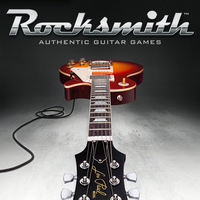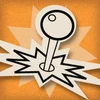

Rocksmith
Ubisoft • Sep 06, 2022
61
Achievements
11,003
TH Points
191-233h
Time to Complete
Giant!
Beat 2,000,000 points in the Guitarcade game: Big Swing Baseball
How to unlock the Giant! achievement in Rocksmith - Definitive Guide
-instead of bending, you can hammer-on, or even directly play the note you are supposed to be bending up to.
There are three types of bends in this mini-game. Small, medium, and big. Playing 2 frets above the fret you are supposed to be bending, usually works for the small and medium bends. The big bend requires 3 frets above the suggested fret .For example, if it shows a 5th fret medium bend, you could just hammer-on to the 7th fret instead of bending.
-If there is no bend, then just play the suggested note.
-The game becomes very fast, but you are able to pause the game to your advantage. This allows you to see the fret and string that you need to play, without needing to rush.
-The more hits you get in a row, the more score you obtain. When you get a strike, it resets.
Also, the speed of the drum track tells you the speed the ball will come at, i.e. the timing for playing your note.
This is a confusing game, and that's due to the lack of instruction you are given. This is a game that tests your bending skills. The game will give you a fret number, string color and the action you must perform on the string. For example, it will show you the number 5 and then highlight the yellow string. When it highlights the string, it will then show you the amount of bend, if any, you must perform on the string. Sometimes you won't have to bend the string, which is illustrated by a straight line, or you'll have to do a full bend which you will see the string bend down and touch the adjacent string.
Once you are given the fret number, color and action, the pitcher will pitch the ball and you must perform the proper action at the right moment to hit the ball. The hit type will depend on how close you are to matching the timing. Swing a little early and you will end up with just a single. Contrary to what your little league coach always taught you, DO NOT keep your eye on the ball. There is a visual and audio cue on when to swing. Behind the pitcher you will see four lights. The fourth light is when you must swing. For bends, you must reach the proper pitch at that light. There is also an audio cue in the form of a metronome which matches the lights. This is in 4/4 time.
Each time you hit the ball, your combo score will increase. It continues to increase until you swing and miss. Once the combo is high enough, a grand slam can net you over a million points. Maintaining a high combo is the key for this.
To give yourself a little extra time, use the "Pause Cheat" method outlined in Fast Fret once you know the swing type as you don't have much time before you must swing.
This game isn't too bad, but reaction time is important. The biggest problem with the game is its ability to recognize a bend. As of now, only a couple of people have actually reached the holy grail 2,000,000 mark. The game shows you what fret to play first, then a second later tells you what string to play and if it must be bent or not.
A good trick to use is to wait until after the first two beeps, then resort to the pause method mentioned in the roadmap.
Another Trick:
If there is a bend, then try playing a note higher than the shown fret number. A bend would create a higher pitch, so depending on how much bend they want (There's 1/2 bend, full bend, and 1.5 bend which bends past adjacent strings) you want to move your finger to a higher fret - one fret higher for each step up.
Overall, it's not a difficult game at all, especially compared to some of the other minigames. You have three lives (outs) and each player has the right to two errors (missed three times = three strikes, player out, third player out = three outs = game over). If the ball is hit, errors are reset. This is shown by the balls in the lower right corner. For each successful hit, points are awarded.
Impact stages
The strike itself is divided into 4 stages, each accompanied by sound signals and the next square on the screen lights up. In order:
1. The fret we are playing is shown. The string at this moment can already be determined by the tone of the signal being supplied.
2. The string we are playing is shown.
3. A pull-up or clean string is shown. Please note that suspenders vary in strength. This is shown by the height of the wave and how much to pull, but the game is not very attentive to the pull force in general.
4. Simultaneously with the fourth signal, you need to play a note. It is important that not after the fourth, but simultaneously with it.
Strike strategy
A simplified strategy looks like this (for a right-handed person): simultaneously with the second signal, press start on the remote control with your right hand, and press the desired string on the desired fret with your left hand. We unpause, the game counts down three seconds - we place our right hand on the desired string and immediately after the third signal we play the string (in fact, almost simultaneously with the third signal). It is advisable to get the hang of pressing the pause on the second signal, so that on the one hand you can see both the fret and the string, on the other hand, after releasing the pause, there is still time to perform the technique. In most cases, you need to play immediately after the third signal; mistakes will be more often on “played late” rather than “played early.” However, you also need to pay attention to the tempo of the drum rhythm - it determines the speed at which signals appear, which means that sometimes you need to slightly delay the performance, and sometimes play literally after the second signal. Everything is decided by split seconds.
Scoring
To get a record you really don't need to play that many shots if you do it consistently. Depending on the accuracy of the note played in time (and possibly in quality, but I didn't notice) you can do:
1. Single (run one quarter - X points)
2. Double (run two quarters - 2X points)
3. Triple (run three quarters - 3X points)
4. Home run (kick the ball into the stands, run all 4 quarters and get 5X points).
5. If at the moment of the hit there is a player on each base, then the home run becomes a grandslam and brings 10X points. As you can see, it’s most profitable to hit 3 singles and then a home run, but it’s unlikely that you’ll be able to hit it on purpose.
"X" in this scoring calculation depends on how many hits you land in a row. With each subsequent hit, “X” increases significantly; a home run after ten successful singles in a row will bring a good half of the record.
If nothing works out
Of course, it is advisable to first practice performing the technique in a technical pull-up exercise in order to learn how to play it consistently. The technique is generally simple, and its execution should not cause any special problems after training.
Problems arise because your guitar makes its own specific adjustments to the sound, and therefore the console reads your playing incorrectly.
The thinner the strings on the guitar, the easier it is to pull them accordingly. If the passage is very difficult, it makes sense to tighten the strings to a thin “9”.
If you don’t want to change the strings, then instead of bending, you can try playing hammer-on. In general, there are three types of suspenders in this mini-game: small, medium and large. Playing two frets above where you should have tightened will usually work as a slight or medium tightening. For a big lift, you can play three frets higher. For example, instead of a middle pull-up on the 5th fret, you can play a hammer-on on the 7th fret.



 Carlos Again
Carlos Again  TrueAchievements
TrueAchievements  RichardW1001
RichardW1001  Wozamil, Bezenko, DLC
Wozamil, Bezenko, DLC  stratege.ru
stratege.ru  PSNProfiles
PSNProfiles